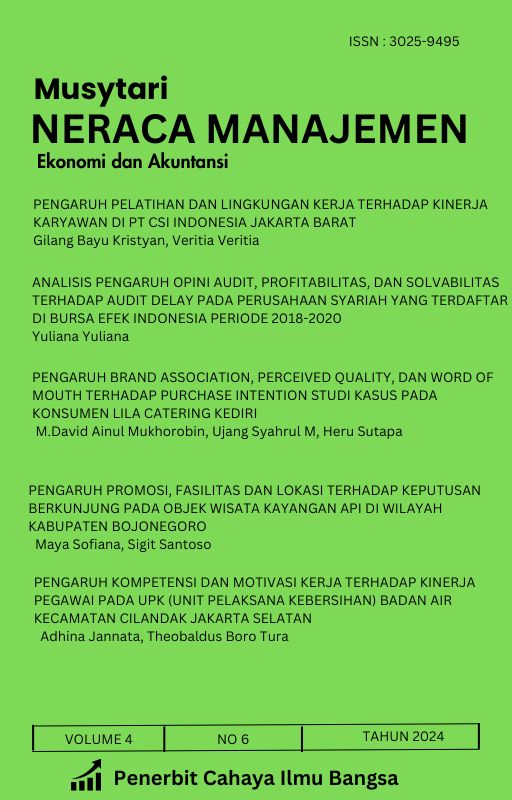PENGARUH RELIGIUSITAS WISATA HALAL TERHADAP KEPUASAN WISATAWAN YANG BERKUNJUNG KE BANTEN LAMA
Main Article Content
Abstract
Religiusitas wisatawan menjadi faktor yang penting dalam mempengaruhi kepuasan mereka selama berkunjung. Wisata halal diyakini menjadi salah satu faktor yang mempengaruhi kepuasan wisatawan muslim, namun kepuasan wisatawan muslim juga tergantung pada tingkat religiusitas yang mereka miliki. Tingginya atau rendahnya tingkat religiusitas seorang wisatawan juga akan berdampak pada niat perilaku terhadap loyalitas terkait dengan kepuasan pelanggan. studi tentang dampak religiusitas masih sangat terbatas, oleh karena itu religiusitas dijadikan sebagai variabel moderasi untuk mencari jawaban atas pengaruh wisata halal terhadap kepuasan wisatawan muslim. Penelitian ini menggunakan pendekatan kuantitatif yang bertujuan untuk mengetahui hubungan antar variabel, alat analisis menggunakan analisis hipotesis dan asumsi klasik. Berdasarkan hasil uji hipotesis dapat diketahui bahwa nilai sig < 0,05 yaitu sebesar < 0,001 sehingga dapat ditarik Kesimpulan bahwa terdapat pengaruh variable X terhadap variable Y
Downloads
Article Details

This work is licensed under a Creative Commons Attribution-NonCommercial 4.0 International License.
This work is licensed under a Creative Commons Attribution-ShareAlike 4.0 International License.
References
Alhakimi, R. S., & Weishaguna. (2022). Pengembangan Wisata Religi Banten Lama. Bandung Conference Series: Urban & Regional Planning, 2(2), 535–542. https://doi.org/10.29313/bcsurp.v2i2.3618
Dzulhidayat. (2022). Pengaruh Wisata Halal Terhadap Kepuasan Wisatawan Dan Dampak Moderasi Religiusitas. הארץ, 10(8.5.2017), 2003–2005.
Muthmainnah, S. R., & Rubiyanti, R. N. (2020). Pengaruh faktor pendorong dan penarik minat wisata halal ke luar negeri dengan religiusitas sebagai variabel moderator. Jurnal Penelitian Ilmu Manajemen (JPIM), 5(3), 274–285. https://jurnalekonomi.unisla.ac.id/index.php/jpim/article/view/361
Taufiqqurrachman. (2020). Formatting Online Image of “Halal” Destination through Photography. Open Journal of Business and Management, 08(02), 660–682. https://doi.org/10.4236/ojbm.2020.82040
Wardi, Y., Abror, A., & Trinanda, O. (2018). Halal tourism: antecedent of tourist’s satisfaction and word of mouth (WOM). Asia Pacific Journal of Tourism Research, 23(5), 463–472. https://doi.org/10.1080/10941665.2018.1466816
Zailani, S., Ali, S. M., Iranmanesh, M., Moghavvemi, S., & Musa, G. (2016). Predicting Muslim medical tourists’ satisfaction with Malaysian Islamic friendly hospitals. Tourism Management, 57, 159–167. https://doi.org/10.1016/j.tourman.2016.05.009
Zamani-Farahani, H., & Musa, G. (2012). The relationship between Islamic religiosity and residents’ perceptions of socio-cultural impacts of tourism in Iran: Case studies of Sare’in and Masooleh. Tourism Management, 33(4), 802– 814. https://doi.org/10.1016/j.tourman.2011.09.003
Battour, M., & Ismail, M. N. (2016). Halal tourism: Concepts, practises, challenges and future. In Tourism Management Perspectives (Vol. 19). https://doi.org/10.1016/j.tmp.2015.12.008
Brien, A., Awang, I., Senalasari, W., & Djatnika, T. (2022). Is Muslim Tourist Satisfaction in Muslim Destination and Non- Muslim Destination Different ? 4(2), 115–132. https://doi.org/10.35313/ijabr.v4i2.233
[Bappeda] Badan Perencanaan Pembangunan Daerah Kota Serang, 2011, RTRW Kota Serang Tahun 2010-2030.Serang: Bappeda.
Anggraheni, D. S., Attamimi, H., & Jumardi, J. (2020). Perkembangan Kerajaan Islam di Banten Pada Masa Sultan Ageng Tirtayasa dalam Aspek Politik dan Sosial. Pattingalloang, 7(2), 146–159. https://ojs.unm.ac.id/pattingalloang/article/view/13518.
Indriastuty, H. R., Efendi, A. R., & Saipudin, A. I. (2020). Bangunan Masjid Agung Banten sebagai Studi Sosial dan Budaya. Pattingalloang, 7(2), 119–132. https://ojs.unm.ac.id/pattingalloang/article/view/13517
Diniyah, S. A. (2020). Peranan dan Perkembangan Keraton Surosowan. https://osf.io/preprints/byne5/.
Paloutzian, R. F., & Park, C. L. (Eds.). (2013). Handbook of the Psychology of Religion and Spirituality (2nd ed.). Guilford Press.
Francis, L. J., & Robbins, M. (2005). Religious Beliefs, Personality Traits, and Mental Health. Personality and Individual Differences, 39(4), 751-762.
atson, C. D., Schoenrade, P., & Ventis, W. L. (1993). Religion and the Individual: A Social-Psychological Perspective. Oxford University Press.
Mauludi, Ali. 2014 “Akuntansi Syariah: Pendekatan Normatif, Historis dan Aplikatif” Jurnal Iqtishadia 1 (1): 59-75. http://dx.doi.org/10.19105/iqtishadia.v1i1.366.
Sahida, W., Rahman, S. A., Awang, K., & Man, Y. C. (2011). The Implementation of Shariah Compliance Concept Hotel: De Palma Hotel Ampang,Malaysia. 17, 138–142.
Zamani-Farahani, H., & Musa, G. (2012). The relationship between Islamic religiosity and residents’ perceptions of socio-cultural impacts of tourism in Iran: Case studies of Sare’in and Masooleh. Tourism Management, 33(4), 802– 814. https://doi.org/10.1016/j.tourman.2011.09.003
Taufiqqurrachman. (2020). Formatting Online Image of “Halal” Destination through Photography. Open Journal of Business and Management, 08(02), 660–682. https://doi.org/10.4236/ojbm.2020.82040
Abror, Wardi, Trinanda, P. (2018). The Effect of Halal Tourism on Customer Satisfaction. 57(Piceeba), 275–282. https://doi.org/10.2991/piceeba18.2018.57
Yeo, B. L., Mohamed, R. H. N., & Muda, M. (2016). A Study of Malaysian Customers Purchase Motivation of Halal Cosmetics Retail Products: Examining Theory of Consumption Value and Customer Satisfaction. Procedia Economics and Finance, 37(16), 176–182. https://doi.org/10.1016/s2212-5671(16)30110-1
Taufiqqurrachman. (2020). Formatting Online Image of “Halal” Destination through Photography. Open Journal of Business and Management, 08(02), 660–682. https://doi.org/10.4236/ojbm.2020.82040

